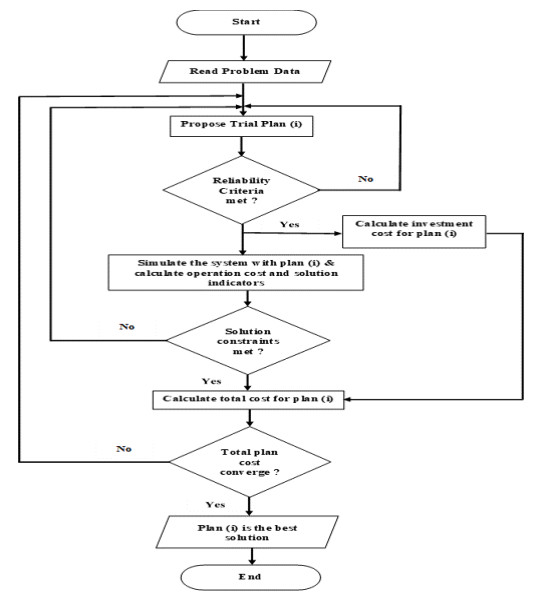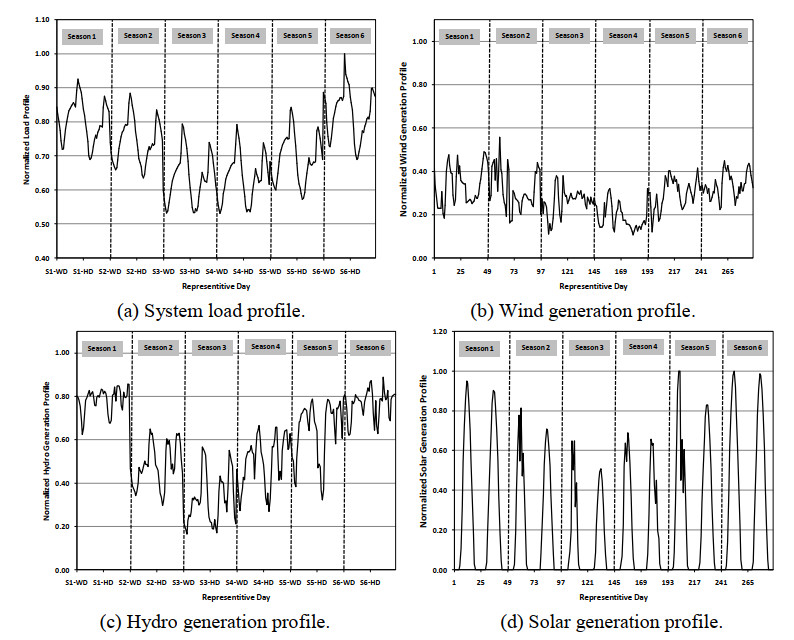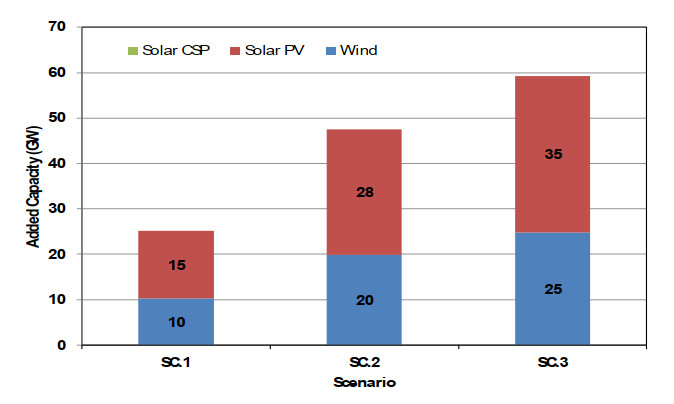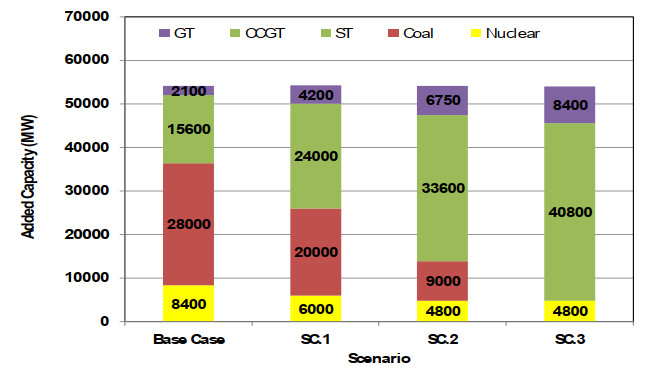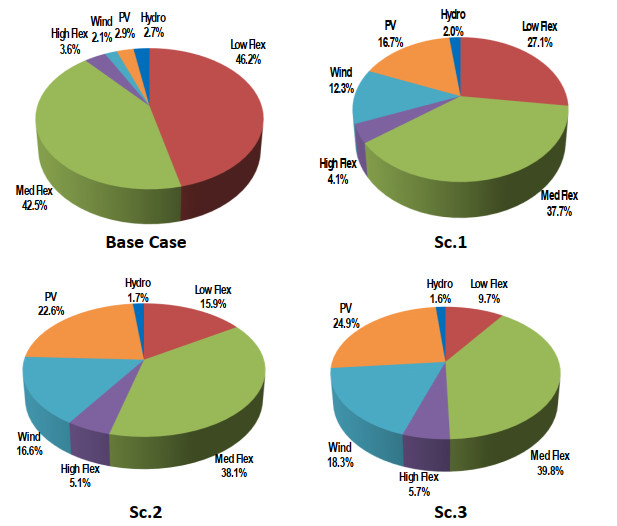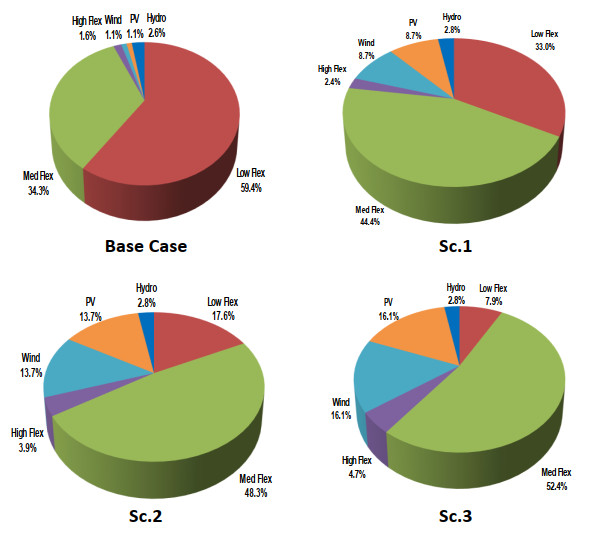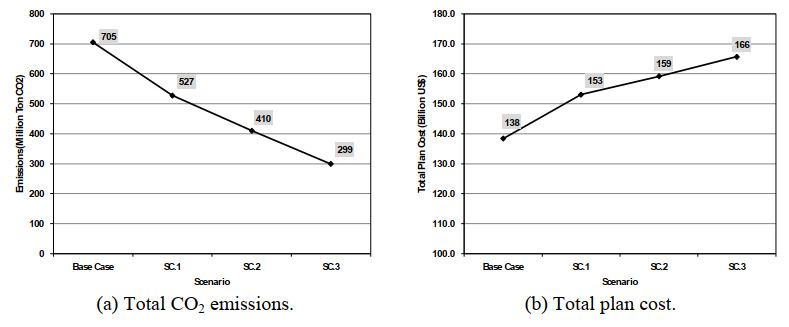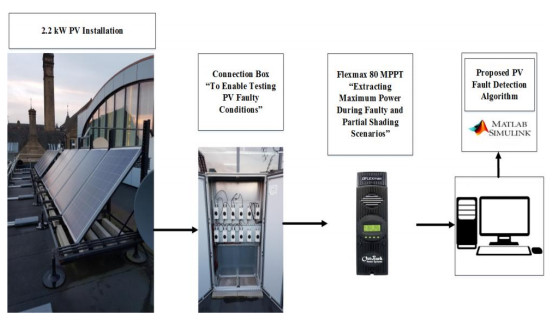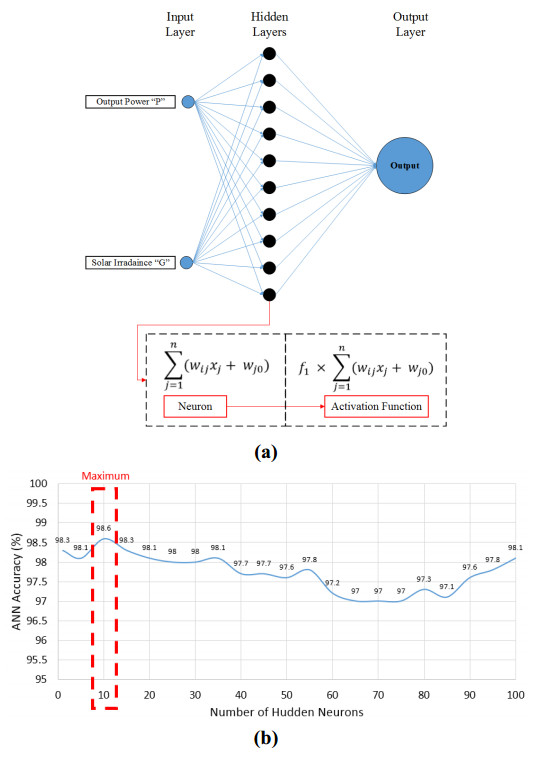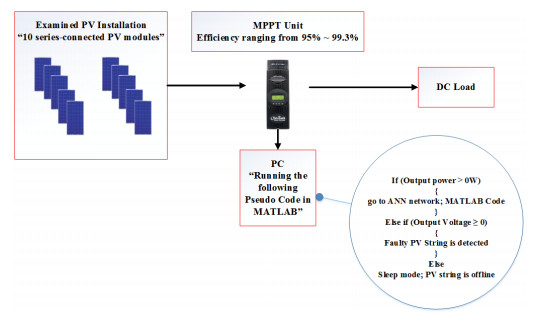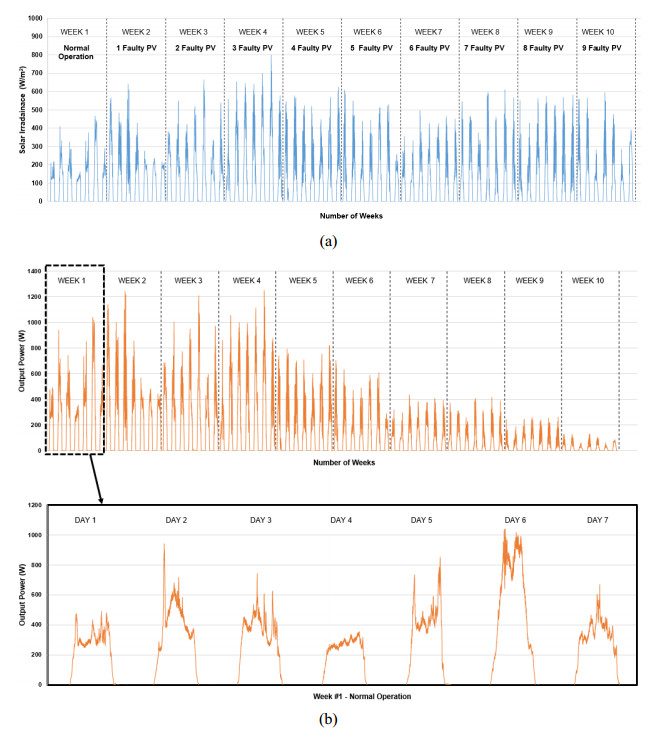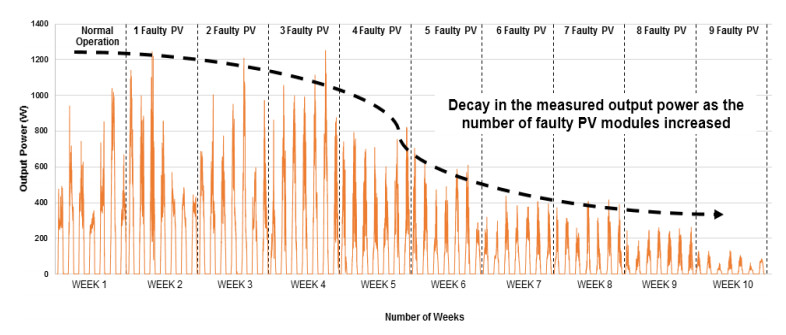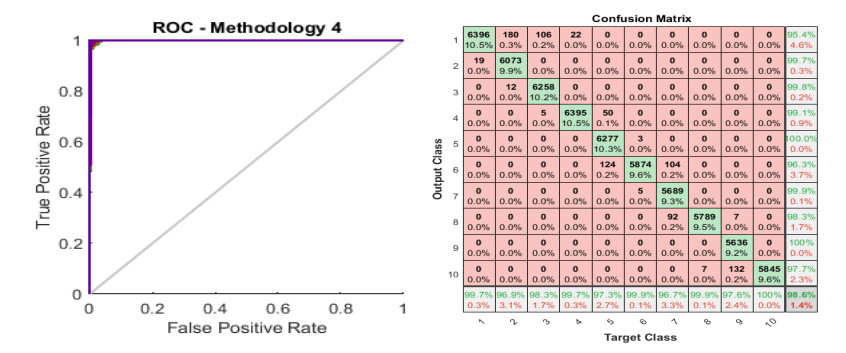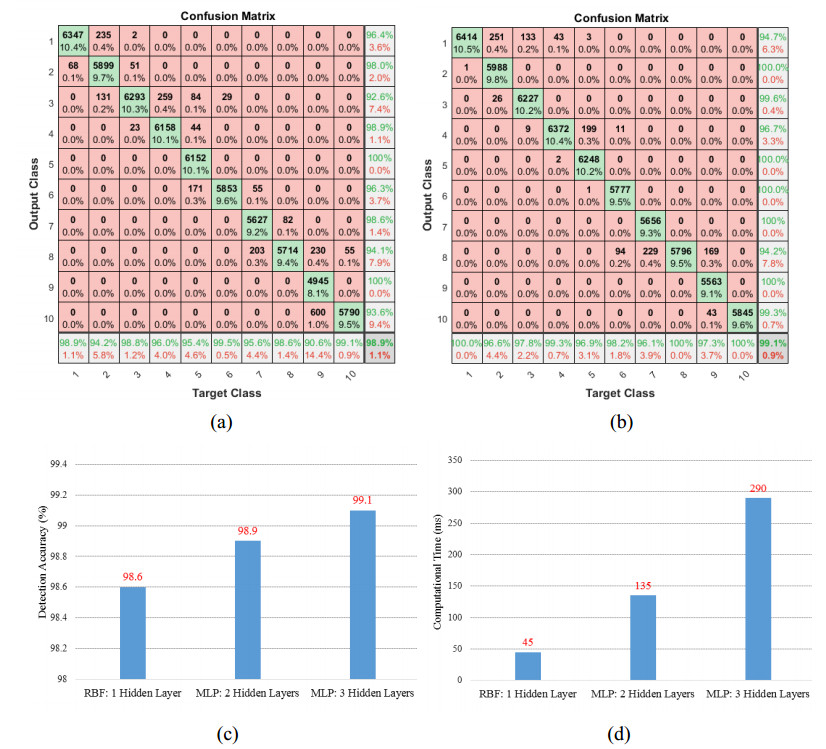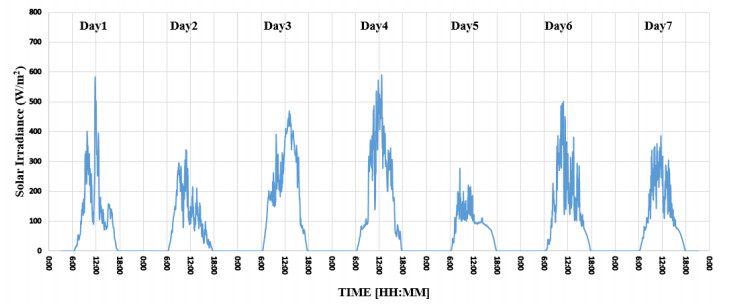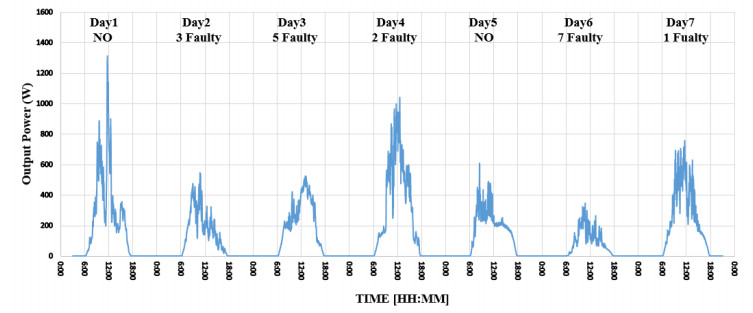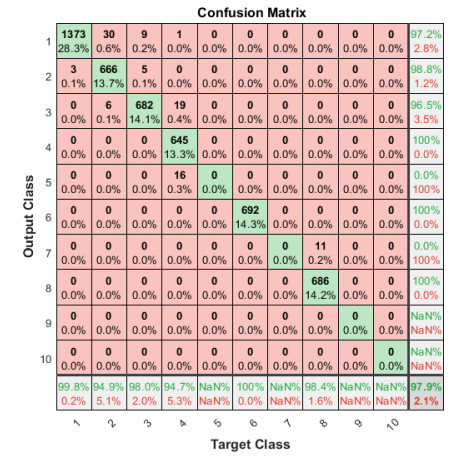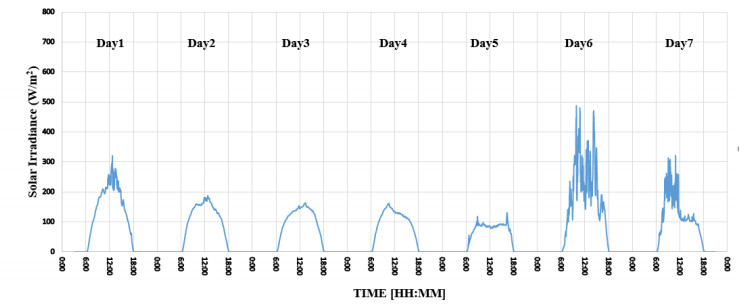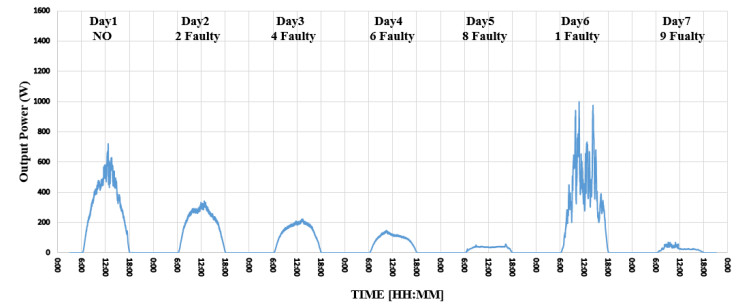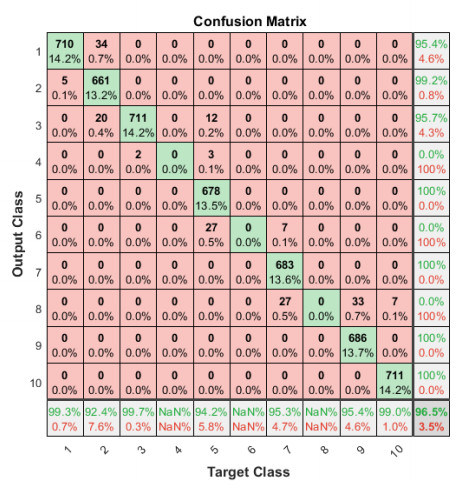In this paper, a fault detection algorithm for photovoltaic systems based on artificial neural networks (ANN) is proposed. Although, a rich amount of research is available in the field of PV fault detection using ANN, this paper presents a novel methodology based on only two inputs for the training, validating and testing of the Radial Basis Function (RBF) network achieving unprecedented detection accuracy of 98.1%. The proposed methodology goes beyond data normalisation and implements a ‘mapping of inputs’ approach to the data set before exposing it to the network for training. The accuracy of the proposed network is further endorsed through testing of the network in partial shading and overcast conditions.
Nomenclature: CCGT: Combined Cycle Gas Turbine; CSP: Concentrated Solar Power; DSM: Demand Side Management; EEHC: Egyptian Electricity Holding Company; EIA: Energy Information Administration; ELCC: Effective Load Carrying Capability; FEPL-MILP: Flexibility Enhanced Priority List-Mixed Integer Linear Programming; GEP: Generation Expansion Planning; GHG: Green House Gas; GT: Gas Turbine; IEA: International Energy Agency; LDC: Load Duration Curve; MBTU: Million British Thermal Unit; MSG: Minimum Stable Generation; REs: Renewable Energies; TSC: Total System Cost; TOE: Ton Oil Equivalent; UC: Unit Commitment; VREs: Variable Renewable Energies
Variables: T: Planning horizon [years]; N: Total number of existing generation units in the system; M: Total number of new generation units to be added to the system by the GEP model; EOC(i, t): Operation costs for existing generation unit (i) in year (t) of the planning horizon (T) [US$]; NOC(j, t): Operation costs for the new added generation unit (j) in year (t) of the planning horizon (T) [US$]; NIC(j, t): Investment cost for the new added generation unit (j) in year (t) of the planning horizon (T) annualized over the generation unit life time [US$]; A(j): Capital recovery factor for new unit (j); AC(j): Added capacity of unit (j) [MW]; Inv(j): Investment cost per MW installed for unit (j) [US$/MW]; I: Discount rate [%]; L(j): Life time for unit (j) [Years]; H: Unit Commitment (UC) problem time horizon [Hours]; Cn: Generation cost of generator (n) [US$/MWh]; VOMn: Variable O & M of generator (n) [US$/MWh]; FOMn: Fixed O & M of generator (n) [US$/MW]; Pmaxn: Installed capacity of generator (n) [MW]; Ph, n: Output power generated by generation unit (n) in hour (h) [MW]; SUCn: Start-up cost for generation unit (n) [US$]; Sh, n: Binary variable representing the state of generation unit (n) in hour (h), 1 indicates the generator is on while 0 indicates the generator is off; Sh-1, n: Binary variable representing the state of generation unit (n) in the previous hour (h-1), 1 indicates the generator was on while 0 indicates the generator was off; CCRESh: Total penalty cost of curtailed VREs generation in hour (h) [US$]; CLOLh: Total penalty cost of curtailed load in hour (h) [US$]; CurtREsh: Total curtailed renewable generation in hour (h) [MW]; CREs: Penalty cost for each MW of curtailed renewable generation [US$/MW]; CurtLOLh: Total curtailed load in hour (h) [MW]; CLOL: Penalty cost for each MW of curtailed load [US$/MW]; U: Number of dispatchable generation units; DispCapu, t: Installed capacities for dispatchable generation unit (u) in year (t) [MW]; CCW, t: Capacity credit of wind capacities in year (t) [%]; WindCapt: Total installed wind capacities in year (t) [MW]; CCS, t: Capacity credit of solar PV capacities in year (t) [%]; SolarCapt: Total installed solar PV capacities in year (t) [MW]; RMt: Minimum required reserve margin in year (t) [%]; PLt: Annual system peak load in year (t) [MW]; Curt_REst: Total maximum curtailed renewable generation in year t [MWh]; REs_Gent: Total available renewable generation in year t [MWh]; K: Maximum allowable renewable generation curtailment for each year of the study horizon [%]; R: Total number of existing and new renewable generation units; Lh: System load in hour (h) [MW]; LOLh: System curtailed load in hour (h) [MW]; SRh: Required spinning reserve in hour (h) to be covered by dispatchable generation units [MW]; σVREsh: Standard deviation of the VREs forecasting error for hour (h) [MW]; RUPn: Ramp up rate of dispatchable generator (n) [MW/hour]; RDNn: Ramp down rate of dispatchable generator (n) [MW/hour]; Tonn: Total number of successive hours in which the dispatchable generator (n) is on [Hours]; TminUPn: Minimum up time of dispatchable generator (n) [Hours]; Toffn: Total number of successive hours in which the dispatchable generator (n) is off [Hours]; TminDNn: Minimum down time of dispatchable generator (n) [Hours]; Hyd_Ph, w: Output power of hydro unit (w) in hour (h) [MW]; Hyd_limw: Annual energy limit of hydro unit (w) [MWh]; W: Total number of hydro generation units; Fuel_Consn: The annual amount of fuel consumption by thermal generation unit (z)
[TOE]; Elec_Genn: The annual electricity generation of thermal generation unit (z) [GWh]; ηn: Thermal efficiency of thermal generation unit (z) [%]; Emissionz: Annual emissions generated by thermal generation unit (z) [Ton]; Z: Total number of thermal generation units; Emission_Coef: Emission coefficient representing the amount of emission released from burning one Million British Thermal Unit (MBTU) of fossil fuels in thermal generation units [Kg Co2/MBTU]
1.
Introduction
Over the past years, the world has depended mainly on conventional energy resources like coal, oil and natural gas to meet its increasing electricity demand. Those energy resources however are expected to deplete over the next years, suffer from price fluctuations and release GHG emissions into the environment. Because of these challenges, the world has started to increase the utilization of REs for meeting its electricity demand. REs can be broadly classified into VREs like wind, solar and tidal resources and non-VREs like hydro and geothermal resources which show more stable and predictable output compared to VREs. Worldwide, and driven by the availability of its natural resources, the continuous reduction in its investment costs due to the technology development, the share of VREs in the world energy mix is increasing from year to year. According to the International Energy Agency (IEA), VREs from wind and solar power accounted for 71% of the total added renewable capacities in the period (2011–2017) while hydro power, Bioenergy and other renewables accounted for the rest [1]. On the other hand, VREs especially from wind and solar resources suffer from intermittency. Intermittency comprises two separate elements: non-controllable variability and partial unpredictability. Variability refers to the fact that, VREs generation continues varying in accordance with the variation of the driving meteorological factors (like wind speed and solar intensity in case of wind and solar generation). In terms of predictability, predicting the output of VREs generation is much more difficult than predicting the output of dispatchable generation or load even for few hours ahead.
The intermittency of VREs will result in the deformation of the net load (system load minus VREs generation) pattern to be met by dispatchable generation units. This deformation will result in the reduction of the system minimum net load level as well as increasing the amplitude and frequency of the net load ramps. Accordingly, this net load deformation will introduce a number of technical and economic problems that can threat the stable and economic operation of the power system. The technical problems include supply/demand imbalances and cyclic operation of thermal generation units which will cause these units to work at its Minimum Stable Generation (MSG) levels with reduced efficiency and also increasing the ramping requirements from these units. This cyclic operation will also increase the mechanical stress on the generation unit's internal parts hence resulting in increased maintenance requirements and reduced life time of thermal generation units. The economic problems will cover the economic losses in the national economy due to the shortage in electricity supplies, increased operation and maintenance costs, life time reduction and reduced efficiency of thermal generation units due to the cyclic operation [2,3,4,5].
Analyzing the time scale for VREs variations shows that, VREs variability can introduce significant variations in the net demand over the different time scales ranging from seconds, minutes, hours and up to monthly time scales. Second to minute variations usually have small effects compared to hourly and longer time scale variations. In case of wind power for example, small-scale variations are smoothed out due to the inertia of the large rotating wind turbine blades so that, the sharp wind variations occurring in such limited time scales have negligible effects. Similarly, and for solar power, the intensity of solar radiation shows a high stability at these low time scales and once again, these second to minute variations have limited effects on the power system operation. Accordingly, and due to its effect on the dispatchable generation scheduling process, the analyses of VREs variability usually focus on the hourly time scale variations [6,7,8].
Classical GEP models have usually focused on the expansion of conventional electricity generation options (basically from thermal and hydro power plants) with limited modeling capabilities of VREs characteristics and their possible integration problems that may arise from increasing its share in the future electricity generation mix. In addition, such models have relied on simplifying the operational characteristics of dispatchable generation options so that, the dynamic limits like ramp rates, MSG level and minimum up/down times are usually ignored during the simulation of generation units operation and the calculation of the system operating costs. As a result, for these modeling approximations, classical GEP models can hardly capture the intermittency of VREs and their technical and economic impacts on power system operation. However, with the increased penetration of VREs in electricity generation, there will be a strong need to develop new GEP models capable of covering the previous issues during the process of optimizing the future mix of new generation capacities to be added to the power system.
In this regard, this paper will propose a new GEP model capable of accounting for the VREs intermittency and its detailed chronological characteristics as well as the dynamic limits of dispatchable generation units. In addition, the new model will also consider the capacity credit of VREs and operating reserve required to integrate these energies. Later, this model will be tested on a practical case study of the Egyptian power system which has ambitious targets to expand the share of VREs in its future energy mix. The paper is structured as follows: section 2 will provide a definition for generation mix flexibility and its role in integrating VREs. Then, section 3 will review the role of operating reserves in integrating VREs. Section 4 will review the concept of VREs capacity credit. Section 5 will introduce the mathematical formulation of the proposed GEP model. Section 6 will provide a description of the solution technique used for solving the developed model while section 7 will present the case study of the Egyptian system along with its results. Finally, section 8 will conclude the results obtained in this research.
2.
The need for generation mix flexibility
The intermittency and seasonality of VREs makes their integration into power systems a challenging task and increases the uncertainty of meeting the system demand [9].The challenge of integrating VREs into existing power systems depends on many factors including, availability of VREs generation, its correlation with demand and the flexibility of the power system in question [10]. As was previously mentioned, the intermittency of VREs will affect the net load in two main forms, increasing the net load variability (frequency and magnitude of load ramps) as well as decreasing the system minimum load below the levels accepted by system operators in terms of generation unit's technical and economic constraints. In response to these uncertainties, the power system should be able to quickly modify the output of its dispatchable generation units to keep tracking the net load variations and hence preserving the electricity supply/demand balance and the quality of service delivered to the customers.
The ability of the power system to deploy its resources to respond to the changes in net load is widely referred to as power system flexibility [11,12]. In other words, flexibility measures the degree by which a power system will be capable of handling the overall uncertainty and variability in net demand [13]. Power system flexibility can be provided from different sources including dispatchable power plants, energy storage technologies, electric interconnection and Demand Side Management (DSM) programs. Dispatchable power plants (including thermal and hydro power plants) can secure the required degree of flexibility through providing the required ramping capabilities, reducing its output to the MSG levels in order to accommodate higher VREs generation levels in addition to the ability of quickly start up and shut down. Energy storage can provide the required degree of flexibility through storing the excess VREs generation and regenerating it quickly when needed by the system. Similar to energy storage, the electrical interconnection can export the excess VREs generation and import the required amount of electricity (up to the tie line limits) when needed. DSM programs can be used to alter the system demand pattern in a way to make it more correlated with the available VREs generation. Although all the previous sources of flexibility can play a significant role in integrating VREs into the power system, the rest of this paper will focus on the flexibility available from dispatchable generation units and how GEP can find the suitable mix of these units to integrate the required amount of VREs generation into the power system while mitigating the resulting technical and economic problems.
3.
Role of operating reserves in integrating VREs
During power system normal operation, it's a common practice that the committed generation capacity exceeds the system load by a certain amount referred to as the system operating reserve. This operating reserve is usually kept to protect the system against any unplanned events that can challenge the supply/demand balance. Such events include for example, the forced outage of one or more of the large generation units or transmission lines, unexpected increase in the system load over the previously forecasted value and deviation in actual renewable generation from the forecasted level. Operating reserve can be classified into different categories either according to the type of event requiring response, the time of the response or the direction of response. Operating reserve can be also classified by the source of additional power supplied into spinning and non-spinning reserves. Spinning reserve refers to the additional generation capacities that can be provided from the generation units already synchronized to the grid and are generating with capacities less than their full rated capacities. Such type of reserve can be supplied to the grid within 10 to 15 minutes of contingent event occurrence. On the other hand, non-spinning reserve refers to the additional generation capacities that can be provided from the generation units not synchronized to the grid but able to be synchronized quickly within 10 to 30 minutes.
For thermal based power systems, the amount of spinning reserve applied is usually set to cover the outage of the largest generation unit in the system (N-1 criterion) however, for power systems with VREs generation capacities, the amount of spinning reserve applied is extended to cover the deviation in VREs actual generation from the forecasted levels (forecasting errors). Assuming that, the normalized VREs forecasting errors (normalized to VREs installed capacities) follow Normal distribution with mean (μVREs) and standard deviation (σVREs), then the additional spinning reserve required to cover the VREs forecasting errors in hour (h) is usually set to three times the value of σVREs(h) in order to cover 99.73% of these errors. This assumption is based on the characteristics of normal distribution in which 99.73% of all probabilities lies within three standard deviations on either sides of the mean [14,15,16].
4.
VREs capacity credit
Although VREs are intermittent by nature, yet it can contribute in meeting a part of the system loads and accordingly in enhancing the system reliability. The contribution of VREs in meeting the system peak load is usually referred to as capacity credit. Capacity credit (also referred to as Effective Load Carrying Capability—ELCC) can be also defined as the amount of additional load a system can serve as a result of the addition of a VREs generator without altering the existing reliability level [17,18]. Different factors affect the value of the VREs capacity credit including the correlation of VREs generation with the system load, size of the power system, penetration level of VREs in the system and the geographical spread of VREs. Different methods do exist for the calculation of the VREs capacity credit ranging from the approximate methods including load factor, GARVER approximation and Z-STATISTIC methods to the more sophisticated reliability-based methods. Such methods differ in the amount of data required, the sophistication of the calculations required and the accuracy of the results obtained [19].
5.
Problem formulation
In its classical form, GEP can be widely defined as the process of optimizing the new generation capacities to be installed in the power system to meet the forecasted electricity demand with a certain degree of reliability and minimum cost. The solution of this optimization problem usually implies finding the answer for three main questions, what amounts of new generation capacities are installed, what types of new generation capacities are installed and when to install these new generation capacities [20]. The solution of this problem is usually based on an objective function to optimized (either minimized or maximized) subject to a number of constraints defining a number of targets to be met like for example, certain reliability level, certain share of REs, certain reduction in GHG emissions. Traditional GEP models usually focused on optimizing the mix of dispatchable capacities added to the power system so that, the predicted total system cost is minimum. This total system cost includes of the investments required to add new generation capacities in addition to the production costs of existing and new generation capacities.
While calculating the required investments is relatively easy, most of the traditional GEP models applied economic dispatch models to calculate the production costs. Such economic dispatch models consider only the main technical and economical characteristics of the dispatchable generation units while avoiding the more detailed operational characteristics especially those related to operational flexibility [21,22]. More important, those models usually lack the accurate representation of the chronological behavior of the system demand and VREs generation patterns and accordingly underestimates the resulting impacts of VREs intermittency.
As a result, such classical GEP models will also suffer from a limited capability in selecting the proper mix of new dispatchable capacities added to provide the system with the required degree of operational flexibility. Hence, with the expected booming in the VREs utilization for power generation, it becomes essential to develop new GEP models capable of covering the previous issues in order to find the optimum generation mix that maximizes the utilization of VREs available resources while not compromising the healthy technical or economical operation of the power system. As was mentioned previously, most of the VREs integration challenges occur over hourly or longer time scales. Accordingly, this research will develop a new GEP model based on the solution of the hourly UC problem which is usually capable of covering the detailed operational characteristics of generation units in addition to its capability of representing the chronological demand and VREs patterns over the hourly time scale.
The mathematical formulation of the new GEP model will consist of the following parts:
5.1. Objective function
Similar to classical GEP models, the objective function of the new GEP model will be based on the minimization of the Total System Cost (TSC) defined as the sum of the present worth of new investments and the operation costs of existing and new generation units [23].
The annualized investment cost for each of the new added generation units can be calculated using Eqs (2) and (3) [20,23].
In order to account for the detailed technical and economic characteristics of the existing and new generation units (for e.g., modeling dynamic limits like ramp rates, minimum generation level, up/down times) as well as the chronological behavior of the system demand and VREs generation, the calculation of the operation costs for the existing and new generation units will be done using a UC model. Using the UC model will also enable the estimation of the resulting economic impacts of the curtailments in system demand and VREs generation due to the lack of generation flexibility. Equation (4) shows the operation costs as calculated by the new GEP model along with its different components.
The insufficient system flexibility will reduce the system ability to integrate the required amounts of VREs generation and as a result, the system operator may need to curtail a part of the available VREs generation. On the other hand, if the available VREs generation drops below the previously forecasted levels and the system lack flexible generation units to quickly recover this VREs output reduction, the system operator may need to curtail a part of the system load to keep the supply/demand balance. In order to penalize the insufficient system flexibility into the optimization problem, the penalty costs of curtailed VREs generation (CCREsh) and curtailed system load (CLOLh) are added to the objective function to reflect the additional costs paid by the system due to the lack of sufficient system flexibility. These costs can be calculated according to the following equations:
The solution of the UC problem will be based on the hybrid Flexibility Enhanced Priority List-Mixed Integer Linear Programming (FEPL-MILP) method. Compared to traditional solution methods, this method will provide three main advantages. First, the method can provide fast and accurate results for power systems composed of large number of generating units with low computational resources (the model can run on normal desktop computers). Second, the method can study the technical and economic impacts of generation mix flexibility on integrating VREs in power systems. Finally, the method will still keep accurate representation of load and VREs chronological behavior over the hourly time scale. More information about the formulation of the UC problem and the FEPL-MILP method is available in [24].
5.2. Problem constraints
Two main groups of constraints will be applied to the GEP problem solution, the first group includes the planning constraints applied to limit the solution to have certain characteristics in terms of reliability and acceptable level of VREs curtailments. The second group of constraints includes the short term operational constraints applied to preserve the demand balance, operating reserves and generation units' dynamic limits (such as the MSG levels, ramp rates, up/down times). The following equations show the description of each of these constraints:
5.2.1. Planning constraints
For each year (t) of the planning horizon (T), the following two constraints are applied. The first of them is applied to keep a certain level of system reliability as measured by the minimum reserve margin of the system. This reserve margin will define the percentage by which the system total firm capacity exceeds the system peak load. The second constraint will be applied to limit the maximum annual renewable generation curtailment to certain level:
5.2.1.1. System reliability
5.2.1.2. Renewable maximum curtailment
5.2.2. Operational constraints
For each hour (h) of year (t), the following short-term operational constraints are applied [24]:
5.2.2.1. Hourly demand balance
5.2.2.2. Spinning reserve
5.2.2.3. Generator output limits
5.2.2.4. Generator ramping limits
5.2.2.5. Generator up/down time limits
5.3. Modeling hydro power plants
Most of the large hydro plants are equipped with reservoirs for storing water and controlling its flow to serve the dual purpose of controlling irrigation requirements and power generation. Accordingly, the dispatch and operation of these hydro plants is limited either by the demand on electricity or by the required amount of water to be released for irrigation purpose. In this way, the developed GEP model will deal with hydro power plants as limited energy dispatchable power plants so that, during each year of the planning horizon, the sum of the hourly generated power for each of these plants is not to exceed a given annual energy limit proportional to the annual amount of water released. This constraint is given by Eq (17).
5.4. Estimation of fuel consumption and GHG emissions
As a part of the obtained solution, the model will calculate the amount of fossil fuel consumed by thermal generation units that will be committed to serve the net load (after utilizing all the available REs generation). For each thermal unit, the amount of fuel consumption in Ton Oil Equivalent (TOE) is inversely proportional to the thermal efficiency of this unit so that, the more efficient is the unit, the less fuel it will consume to generate the required amount of electricity. Equation (18) shows the fuel consumption for each of the thermal generation units [25].
In this regard, it's important to highlight that, the thermal efficiency is a unique characteristic for each generation unit and varies depending on a number of factors including the technology of thermal unit (steam, combined cycle, gas turbine), the size of the unit, the life time and technical conditions of the unit and the unit loading (partial loading usually results in lower efficiency than full load operation).
Accordingly, the amount of emissions released by each thermal unit can be calculated considering the emission factors of the different fuel types as given by Eq (19).
It's important to mention that, Eq (19) can be applied to any type of emissions including for example, Carbon dioxides (COx), Sulphur dioxides (SOx), Nitrogen dioxides (NOx) depending on the type of emission given by the emission coefficients applied.
5.5. Representation of demand pattern
The solution of the GEP optimization problem requires accurate representation of the forecasted electricity demand (forecasted peak load and annual energy demand) as well as its annual variations from one season to another, one month to another or even from one hour to another. This representation will help to find the proper mix of new generation capacities to reliably meet the forecasted demand and following its annual variations. This representation will be also crucial in calculating the system production costs as a result of operating the existing and new generation units to meet the varying net demand. Traditionally, most of the long term GEP models have depended on the Load Duration Curve (LDC) for representing the demand characteristic due to its ability to simplify the required technical and economical calculations inside the model. However, using LDC to represent the system demand won't allow the model to precisely consider the chronological behavior of the demand so that, the model won't be able to recognize the portion of the year with the system least or peak demand or to recognize the most variable demand. On the other hand, applying a detailed hourly representation of the system demand will increase the complexity of the problem, require more time and computational resources to find the optimum solution.
The developed GEP model will recover from this problem by applying the concept of representative load regions in which, the annual load pattern is divided into parts referred to as load regions with each representing the load characteristics in a certain time period of the year such as a season or a month. For each of these regions, typical representative daily load profiles (which can be further broken down into parts) are input to the GEP model so that, the GEP model can consider the major characteristics and variations of the system annual load pattern during the optimization process. Figure 1 provides an example of the load regions representation for a typical power system in which, the annual load pattern is cut down into (k) load regions with each represented by (m) days and each day is in turn broken into (n) parts. It's worth to mention that, several commercial planning models like the MESSAGE and the MARKAL/TIMES models apply similar approaches [26,27,28].
It should be noted that, as the number of load regions increases, the accuracy of the demand representation inside the model also increases however, on the other hand, the complexity of the GEP problem becomes higher. Hence, it's important to select the proper number of load regions required to accurately represent the system load characteristics while not increasing complexity of the problem.
5.6. Modeling REs generation
For most of the classical GEP models, REs have been modeled as a negative demand that should be subtracted from the initial system demand to obtain the net demand. This net demand is then transformed into net LDC to be used in the GEP model optimization. Once again, although this technique will simplify the solution however, it will result in losing the chronological sequence of the REs generation patterns. Losing the information about the chronological REs behavior will cause the GEP model to override the seasonality of REs generation especially of the VREs type and fail to account for the impacts of its intermittency on the system net demand. Hence, the GEP model may fail to account for the correlation between demand and VREs generation patterns and accordingly failing to select the proper mix of new capacities to deal with the VREs intermittency. As a result, the GEP model may favor the introduction of VREs at any share to the system as a mean of reducing the consumption of the more expensive and polluting fossil fuels. Also, the model will favor the introduction of cheap inflexible thermal generation option (e.g., coal power plants) to meet the system net demand.
To recover from this problem, the developed GEP model will again apply the representative load regions technique in a way similar to the previous load representation in order to provide accurate representation of the VREs generation patterns while not increasing the complexity of the problem or the required computational resources.
6.
Solution technique
Classically, different mathematical techniques have been applied to solve the GEP optimization problem including for example, the screening curve, Bender's Decomposition, Dynamic Programming and modern Artificial Intelligence methods [29,30,31,32,33,34,35,36,37,38]. For solving the developed GEP model, a solution technique inheriting Bender's decomposition method is applied in which the GEP problem is divided into a linear master problem and non-linear sub-problems. The linear master problem will work to propose a trial plan for the required new capacities to be added to the system to meet the forecasted demand with the required degree of reliability as calculated by Eq (7). If the trial plan meets the reliability target then, the model will calculate the trial plan annualized investment cost using Eq (2) and (3). On the other hand, the non-linear sub-problems work to simulate system operation considering the proposed trial plan while accounting for the different operational constraints of the dispatchable generation units as well as calculating the system total production cost and the other problem indicators (for example, curtailed REs, curtailed system load) corresponding to this trial plan. The total system cost is then calculated for the trial plan using Eq (1).
The solution algorithm continues proposing trial plans, simulating and calculating the system total cost of each plan. For each plan, the total system cost is compared to the cost of the previous trial plan (cost convergence test). The trail plan that will cause the total system cost to converge to the lowest value while not violating the problem constraints is then selected as the best problem solution (optimum expansion plan). Figure 2 shows a flow chart for the model solution algorithm.
Compared to other solution techniques, this technique will provide a relative simplicity in handling the GEP optimization problem and providing more transparency in tracking the obtained solution. In addition, this technique will enable the integration of the short-term UC model along with its detailed operational constraints and the accurate representation of hourly VREs and load chronological characteristics into the optimization process.
7.
Case study
For the purpose of testing the new GEP methodology, a case study has been prepared for the expansion of REs in the Egyptian grid up to year 2037. Due to the fact that, almost all the hydro resources in the country have been fully utilized for electricity generation, most of this REs expansion will come from VREs resources especially wind and solar generation which have high availability in Egypt. Accordingly, and using the developed GEP model, the study will test a number of scenarios corresponding to different VREs penetration levels as well as testing the different generation options to supply the required degree of generation flexibility in each scenario.
For each scenario, the mix of new generation capacities to be added will be optimized in order to fully integrate the required share of VREs while minimizing the corresponding technical and economic impacts.
7.1. Study assumptions
The study will consider the following assumptions:
1- The base year of the study will be 2105/2016 while the planning horizon will be 20 years from 2016/2017 up to year 2036/2037.
2- As of fiscal year 2015/2016, the total installed capacity of the Egyptian power system has reached 38857 MW of which the hydro power accounts for 2800 MW and VREs (from solar and wind power) accounts for 887 MW. In addition, about 20172 MW of new conventional capacities is currently under construction (committed) in addition to about 3823 MW of renewable energies that will gradually enter to service by the end of fiscal year 2021/2022. The data for existing and committed generation units are based on the Egyptian Electricity Holding Company (EEHC) annual report 2015/2016 [25].
3- The share of hydro generation and its seasonal variations is assumed to be constant along the study horizon at the level of base year with total annual generated energy of 13545 GWh. This assumption is due to the fact that, hydro resources (from the Nile River) are almost constant with no noticeable change from year to year. In addition, hydro generation in Egypt is strongly dependent on the irrigation requirements with no big change in seasonal characteristics over the historical years.
4- The study assumes that the total electricity generation will grow from 186.3 TWh in year 2015/2016 to about 524.7 TWh in year 2036/2037 at an average growth rate of about 5% while the peak load will grow from about 29.2 GW in year 2015/2016 to about 80 GW in year 2036/2037 at an average growth rate of about 5% in line with the historical growth rates.
5- For each scenario, the REs target is met by hydro, solar and wind generation. The study assumes that solar power will contribute by half of the required non-hydro VREs generation while wind contributes the other half. This assumption will allow the utilization of the available solar power potential in the country and reduce the resulting VREs intermittency due to the smoothing effect between wind and solar generation.
6- The study assumes that, the curtailment in renewable generation not to exceed 5% of the available renewable generation while no curtailment in the system load is allowed.
7- Almost all the thermal generation units in the Egyptian grid are dual fired with the capability to operate on gas or oil however, due to the availability of natural gas and its positive environmental impacts compared to oil, the study will assume natural gas as the main fuel for thermal units except those units not connected to the gas grid and operate with oil. For the price of fossil fuels, the study will follow the Energy Information Agency (EIA) projections in its World Energy Outlook 2016—current policy scenario [39] given by Table 1.
8- To calculate the amount of emissions released by thermal generation units, the study follows the CO2 emission factors for different types of fossil fuels [40] given by Table 2.
9- The historical load and REs annual generation patterns have been analyzed to obtain the representative seasonal, daily and hourly profiles to be applied in the study. Accordingly, the representation of the annual load and REs generation will follow the seasonal definition specified in Table 3.
As clarified in section (5), the GEP model should have accurate representation of the load and renewable generation profiles. For this purpose and to reduce the computational requirements, the concept of load regions is applied to keep accurate approximation of the hourly profiles for the load and renewable generation. Figure 3 shows the applied representation for annual load and REs generation profiles in year 2015/2016 normalized to the system peak load and REs total installed capacities respectively. Part (a) of the figure describes the load regions representation of the system annual load profile while parts (b) to (d) will show the similar representation for hydro and VREs.
10- The study considers 10% discount rate in the economic calculations of the model.
11- The added nuclear capacities are assumed not to be less than the planned capacities by the Egyptian government (4 nuclear units each with 1200 MW capacity starting from year 2026/2027).
12- The nuclear fuel price is set to 0.7 $/MBTU and is constant along the study period.
13- The study will consider a minimum reserve margin of 25%.
14- Wind will have a 25% capacity credit while solar power will have zero capacity credit due to the fact that, the peak load of the Egyptian grid occurs in the night.
15- The study assumes that, the dispatchable generation units will be always committed to meet the hourly net demand in addition to the required amount of spinning reserve to cover the different sources of uncertainties including those from VREs generation.
7.2. Study scenarios
The case study will consider four scenarios to test the change in the optimized generation mix for the different REs expansion targets. The first scenario represents the Base case scenario in which no new REs capacities are added to the grid than the actual capacities already in operation or committed up to year 2021/2022 while the remaining three scenarios will test different shares of REs in Egypt' future energy mix during the study period. Table 4 shows the main assumptions for the case study scenarios.
7.3. Power generation candidates
The study considers a wide range of power generation candidates as follows:
■ 1200 MW dual fired (NG/LFO) Combined Cycle Gas Turbine (CCGT) unit.
■ 650 MW dual fired (NG/HFO) steam turbine unit.
■ 1000 MW coal fired steam turbine unit.
■ 150 MW dual fired (NG/LFO) Gas Turbine (GT) unit.
■ 1200 MW nuclear unit.
■ 100 MW wind farm.
■ 150 MW Solar PV farm (without storage).
■ 100 MW Concentrated Solar Power (CSP) unit (without storage).
The technical and economic data for the candidate generation units are summarized in Table 5
[41,42,43]. It's important to mention that, the thermal generation candidates selected show different degrees of operational flexibility as well as different costs for providing it. Accordingly, the model will be free to pick up the required mix of dispatchable capacities to meet the flexibility requirements for each VREs expansion scenario while still meeting the forecasted demand at least cost and maximum reliability.
7.4. Results
The previous scenarios were simulated using the proposed GEP model considering the different assumptions and constraints imposed. For each scenario, the model output includes the optimized new installed generation capacities, the electricity generation, hourly commitment of system generation units, GHG emissions and the system total cost.
7.4.1. New installed renewable capacities
In order to achieve the REs expansion targets in the study scenarios, new renewable capacities will be added to the system from the different VREs technologies mainly wind and solar PV while solar CSP was not selected due to its high capital and operation costs compared to the other renewable technologies. The added new VREs capacities range from about 25 GW in Sc.1 to reach about 60 GW in Sc.3. it's important to clarify that, in all the scenarios, the new added PV capacities will be higher than wind capacities by about 50%. This can be explained by the fact that the energy yield of solar power is lower than that from the wind. Hence, to meet the 50% share from the non-hydro VREs, more new capacities will be constructed from solar PV than from wind. Figure 4 shows the added non-hydro VREs capacities for each of the study scenarios.
7.4.2. New installed dispatchable capacities
For each of the study scenarios, the GEP model will select the optimized mix of new dispatchable generation capacities to be added to the system in order to meet the required reliability criteria previously imposed to the solution as well as providing the sufficient degree of generation flexibility to enable the integration of VREs capacities in each scenario. Figure 5 compares the added dispatchable generation capacities for each of the study scenarios.
From the previous figure, it's clear that, with the increase in the VREs share, the new installed capacities from medium and high flexibility technologies (CCGT and GT) will gradually increase from about 18 GW in the base case scenario to reach about 49 GW in SC.3. On the other hand, the installed capacities from low flexibility technologies (Coal and Nuclear) will decrease from about 36 GW in the base case scenario to reach about 5 GW in SC.3.
7.4.3. Total installed capacities
To reflect the impact of REs expansion on the mix of generation capacities in the system, the system installed capacities are classified according to the degree of flexibility available into three main types. The first type, low flexibility technologies will include the gas, oil and coal fired steam units in addition to nuclear power plants. The second type, the medium flexibility technologies will include combined cycle power plants while the last type, high flexibility technologies will include gas turbine capacities. Figure 6 compares the total installed capacities by type for each scenario in year 2037.
7.4.4. Electricity generation
The results obtained from the GEP model reflect the fact that, introducing additional capacities from VREs will work to reduce the share of thermal generation in meeting the system energy demand which currently constitutes most of the electricity generation in the Egyptian grid. Accordingly, and by the end of the study period, the share of thermal generation will decline from about 95% in the base case to about 65% in SC.3. Analyzing the thermal generation according to flexibility shows that, with the increase in the VREs penetration, the share of the medium and high flexibility technologies will increase due to the increasing need for the operational flexibility available from it for integrating the VREs generation. On the other hand, the share of the low flexibility technologies will go down. Figure 7 compares the total generated electricity by type for each scenario in year 2037.
7.4.5. Hourly commitment of system generation units
In order to assess the role of the generation flexibility available from the optimized energy mixes in integrating the VREs generation into the Egyptian power system, the hourly unit commitment for the generation units in the Egyptian power system was calculated for each hour (H) of the representative days (D) in the representative seasons (S) of the year. Figure 8 shows the hourly unit commitment in year 2037 for each of the study scenarios. From this figure, it's clear that, the output of the low flexibility generation units will show limited variations compared to the output of the more flexible generation units. This will in turn reduce the cycling costs and impacts for low flexible units which usually serve as base load generation and accordingly enhance its economic performance. On the other hand, the medium and high flexibility generation units will play an increasing role in integrating intermittent VREs through providing the required degree of operational flexibility while keeping the supply/demand balance in the system. This obtained result proves that, the optimized energy mixes will enable the integration of the intermittent VREs capacities to meet the future expansion targets proposed in each of the study scenarios without compromising the economic performance or the reliability of power supply in the system.
7.4.6. Total CO2 emissions
The developed GEP model has optimized the mix of new added capacities in a way to increase the share of the VREs generation in meeting the system demand. In addition, the model has favored the addition of clean gas fired technologies (CCGT and GT) driven by their higher flexibility while reducing the installed capacities from the low flexibility coal technology. Accordingly, the calculated amount of CO2 emissions released in each scenario has declined from about 705 million ton in the base case to reach about 299 million ton in SC.3. Figure 9(a) shows the total CO2 emissions for each of the study scenarios.
7.4.7. Total plan cost
For each scenario, the developed GEP model will be applied to find the least cost plan that achieves the VREs integration target while avoiding the curtailment of VREs generation or of the system load. As was previously declared, the model will calculate the discounted TSC for each optimized scenario including the investments required for new capacities and operational costs of existing and new capacities. The TSC is discounted with respect to the base year of the simulation to enable the comparison of the different scenarios. Figure 9(b) shows the total plan cost for each of the study scenarios.
7.5. Analysis of the results
Analyzing the obtained results for the different study scenarios concludes the following:
1- As the share of VREs increases in the system, the resulting intermittency in the system net load will be higher and accordingly call for higher generation flexibility from dispatchable technologies to preserve the system supply/demand balance. Accordingly, the new added capacities will move from the less flexible and cheap base load technologies (coal and nuclear) into the medium and high flexible technologies (CCGT and GT). This important result clarifies the contradiction between the addition of the economically viable base load technologies and achieving the penetration targets of VREs and also proves the close relation between the generation mix flexibility and the integration of higher of VREs shares.
2- As an extension to the previous point, as the share of VREs increases in the system, the share of medium and high flexibility technologies in generating electricity increases while the share of low flexible technologies decrease. This behavior can be explained by the fact that, as the share of VREs increase, the reduction in the system minimum load level as well as the increasing load ramps will call for increasing the operation of the medium and high flexibility technologies to protect the system against these effects and preserve the supply/demand balance as well as securing the required operating reserves. This result was validated by analyzing the detailed hourly UC output for each of the study scenarios.
3- The introduction of VREs will result in positive environmental impact. This impact is magnified by the fact that, the introduction of VREs will reduce the dependency on the low flexibility coal generation units for the sake of the more flexible and clean gas fired technologies. Although the study has focused on the CO2 emissions due to its role in the global warming however, it's important to mention that, increasing the share of VREs will also reduce the other sources of GHG emissions like the sulfur and nitrogen oxides.
4- Looking at the economics of integrating VREs to the Egyptian power system, increasing the share of these technologies will result in reducing the generation from the cheap base load coal and nuclear power plants while increasing the share of medium and high flexibility units operating on the more expensive natural gas and oil and accordingly, resulting in higher operating cost. In addition, VREs technologies suffer from higher capital costs than that of the fossil fired thermal generation alternatives as well as relatively higher O & M costs. As a result, increasing the dependency on VREs will increase the total system cost.
8.
Conclusions
Most of the classical GEP models have focused on optimizing the mix of conventional capacities added to meet the forecasted system demand with approximate or inaccurate representation of intermittent VREs technologies. With the world strong move towards clean VREs generation, there is a strong need to develop new GEP methodologies and models to find the optimum mix of dispatchable generation capacities that will enable the integration of higher VREs shares into power systems while reducing the technical and economic impacts of its intermittency on the system operation. For this purpose, this paper has proposed a modification of the classical GEP methodology to account for the intermittency of VREs as well as the UC constraints and dynamic limits imposed on the operation of dispatchable generation units. A new GEP computer model considering the new developed methodology was then implemented using MATLAB programming language and tested for a practical case study of the Egyptian power system. The case study tested the different scenarios of expanding the share of VREs in the Egyptian grid up to year 2037. The results obtained from this study has clarified the impact of VREs intermittency on the mix of new capacities added to the system so that, with the increase in the VREs share, the selected mix of new added generation capacities will be shifted from the traditional cheap and low flexibility base load technologies towards the more expensive but more flexible generation technologies. Although VREs expansion has resulted in a huge reduction in GHG emissions, it will result in increasing the total system cost driven by additional cost for integrating it. These results which are difficult to obtain using classical GEP models thus strongly highlight the importance of developing new power system planning models to cope with the VREs intermittency as well as the dynamic limits of dispatchable generation units.
Conflict of interest
The authors declare that there is no conflict of interest in publishing this paper.
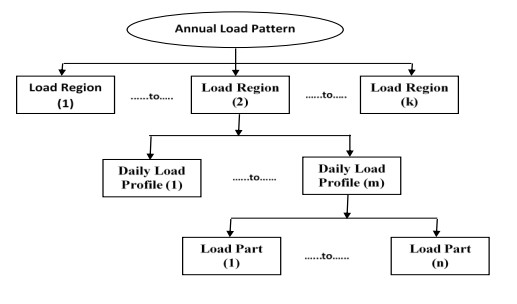









 DownLoad:
DownLoad:
